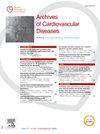Erythropoietin recapitulates ultrasound-assessed hemodynamic and morphological features of hypoxia-induced pulmonary hypertension in mice
IF 2.3
3区 医学
Q2 CARDIAC & CARDIOVASCULAR SYSTEMS
引用次数: 0
Abstract
Introduction
Pulmonary hypertension is characterized by increased pulmonary vascular resistances leading to right ventricular failure. Chronic hypoxia is a risk factor for PH. End-stage renal disease patients with chronic haemodialysis have increased risk of PH. Most of these are treated with erythropoietin (EPO) because of anaemia. Involvement EPO as causative of PH in controversial.
Objective
We investigated if an EPO treatment could reproduce hemodynamic and morphologic features of hypoxia-induced PH and whether endothelial progenitor cells mobilized in PH due to hypoxia, could be involved in EPO-induced PH.
Method
The first group of mice was treated with EPO for 2 and 4 weeks and the 2nd group of hypoxia (10%) was exposed during 2 and 4 weeks. Blood analysis, heart and valves remodeling and function were assessed by high frequency echocardiography (Vevo3100 from Visual sonics) using a linear MS440 and MS500 probe. Isovolumetric relaxation and contraction time were recorded with a pulsed-Doppler window placed at the tip of the leaflets valves and right ventricle strain was also evaluated. Blood pressure and heart rate were recorded. Right ventricular pressure, heart and lung histology and blood circulating endothelial progenitor cells were assessed after 2 weeks.
Results
The EPO treatment for 2 weeks and 4 weeks and hypoxia induce PH with an important increase in pulmonary and right ventricular pressure and RV/LV + septum size attested by pulmonary and peripheral vein pressure increases compared to normoxia animals. Similarly, the treatment with EPO or hypoxia in mice significantly alters the inferior vena cava (IVC) pulsatility index with a decrease in inspiratory fractional shortening. EPO and hypoxia groups show right ventricle hypertrophy as attested by an increased in RV/LV + septum weight ratio and pulmonary artery remodeling increased pulmonary wall vessel thickening of vessels with a diameter below 3–4 μm (pre-acinar and intra-acinar pulmonary vessels) with an elastic fibrosis of alveolar vessels wall. EPO provoked an increase in the blood mobilization of endothelial progenitor cells at a similar extent than hypoxia.
Conclusion
EPO recapitulates hemodynamic features of hypoxia-induced pulmonary hypertension in mice when hematocrit is increased over the physiological range. Nevertheless a pharmacological effect not linked to hematopoiesis is discussed.
促红细胞生成素反映了缺氧引起的小鼠肺动脉高压的超声血流动力学和形态学特征
肺动脉高压的特点是肺血管阻力增加导致右心室衰竭。慢性缺氧是ph的危险因素。终末期肾病患者慢性血液透析增加了ph的风险。由于贫血,大多数患者接受促红细胞生成素(EPO)治疗。EPO是否为PH的病因有争议。目的观察促生成素能否再现缺氧诱导PH的血流动力学和形态学特征,以及因缺氧而在PH中动员的内皮祖细胞是否参与促生成素诱导PH的发生。方法第一组小鼠给予促生成素治疗2周和4周,第二组小鼠给予缺氧(10%)治疗2周和4周。使用线性MS440和MS500探头,通过高频超声心动图(Vevo3100)评估血液分析、心脏和瓣膜重塑和功能。用放置在小叶瓣顶端的脉冲多普勒窗口记录等体积松弛和收缩时间,并评估右心室应变。记录血压和心率。2周后观察右心室压、心肺组织学和血液循环内皮祖细胞的变化。结果EPO治疗2周、4周和缺氧均可诱导PH升高,肺动脉压、右心室压和左室/左室+间隔大小均显著升高,肺动脉压和外周静脉压均明显升高。同样,小鼠用EPO或缺氧治疗显著改变下腔静脉(IVC)搏动指数,吸气分秒缩短减少。EPO和缺氧组右心室肥大,右心室/左室+间隔重量比增加,肺动脉重塑,肺壁血管增厚,直径小于3-4 μm的血管(腺泡前和腺泡内血管)增厚,肺泡血管壁弹性纤维化。EPO引起内皮祖细胞血液动员的增加,其程度与缺氧相似。结论epo重现了小鼠红细胞压积超过生理范围时缺氧肺动脉高压的血流动力学特征。然而,与造血无关的药理作用被讨论。
本文章由计算机程序翻译,如有差异,请以英文原文为准。
求助全文
约1分钟内获得全文
求助全文
来源期刊

Archives of Cardiovascular Diseases
医学-心血管系统
CiteScore
4.40
自引率
6.70%
发文量
87
审稿时长
34 days
期刊介绍:
The Journal publishes original peer-reviewed clinical and research articles, epidemiological studies, new methodological clinical approaches, review articles and editorials. Topics covered include coronary artery and valve diseases, interventional and pediatric cardiology, cardiovascular surgery, cardiomyopathy and heart failure, arrhythmias and stimulation, cardiovascular imaging, vascular medicine and hypertension, epidemiology and risk factors, and large multicenter studies. Archives of Cardiovascular Diseases also publishes abstracts of papers presented at the annual sessions of the Journées Européennes de la Société Française de Cardiologie and the guidelines edited by the French Society of Cardiology.
 求助内容:
求助内容: 应助结果提醒方式:
应助结果提醒方式:


